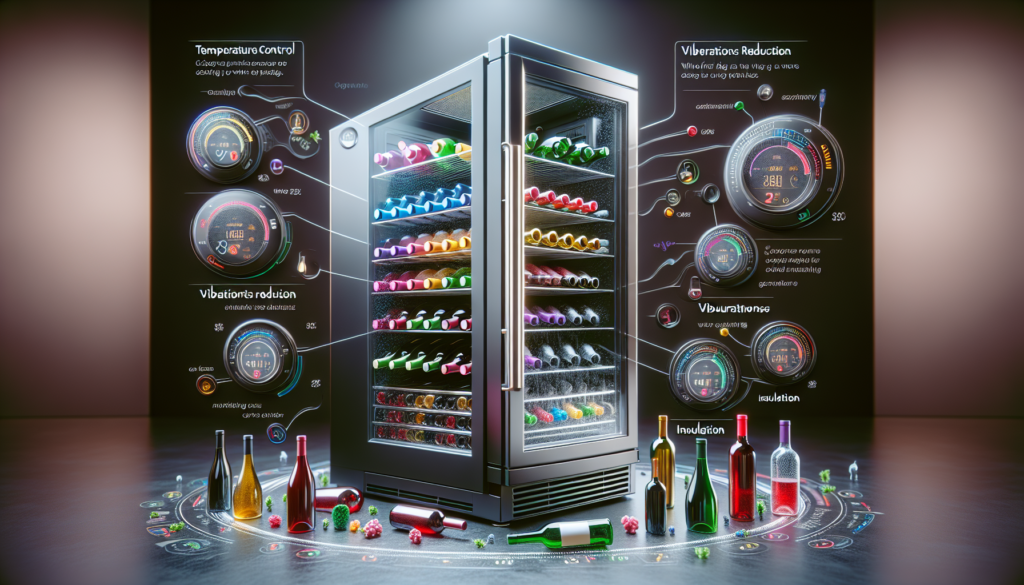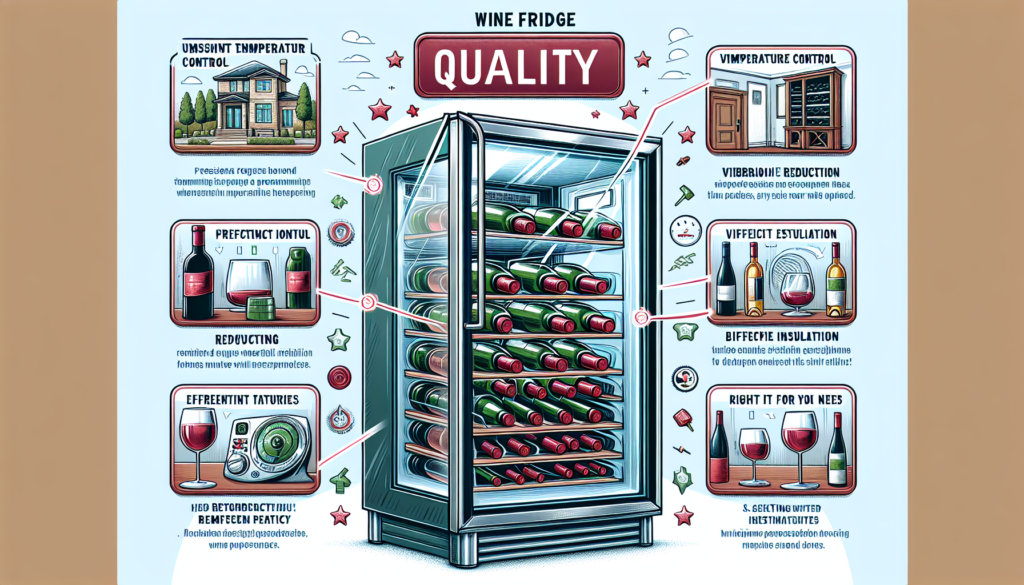Step up your wine game with a wine fridge that not only adds a touch of elegance to your living space but also ensures that your bottles of vino are kept at the perfect temperature for maximum enjoyment. Whether you’re a casual wine enthusiast or a true connoisseur, investing in a high-quality wine fridge is a game-changer. From preserving the flavor and aroma of each wine to providing a sleek and sophisticated storage solution, a wine fridge offers so much more than just a place to stash your bottles. Discover the ultimate wine fridge quality that will take your wine experience to new heights. Cheers!
Factors Affecting Wine Fridge Quality
When it comes to storing your cherished wine collection, the quality of your wine fridge plays a vital role. A high-quality wine fridge not only keeps your wine at optimal conditions for aging and preservation but also ensures that every bottle will provide a delightful experience when it’s time to savor. To help you understand the factors that contribute to the quality of a wine fridge, let’s explore each of them in detail.
Temperature Control
One of the most crucial factors to consider when evaluating the quality of a wine fridge is its temperature control capabilities. Maintaining a stable and appropriate temperature is fundamental for the proper aging and preservation of wine.
Thermostat Accuracy
A high-quality wine fridge should have a reliable and accurate thermostat to ensure that the internal temperature remains constant. Fluctuating temperatures can negatively impact the quality and taste of the wine, so it’s essential to choose a unit with precise temperature control.
Consistency
Consistency in temperature is key to preserving the delicate flavors and aromas of wine. Look for a wine fridge that can maintain a steady temperature without significant fluctuations, as sudden changes can cause chemical reactions that may spoil the wine.
Temperature Range
Different types of wine require different temperature ranges for optimal aging and preservation. A quality wine fridge will offer a wide temperature range, allowing you to store various types of wine at their ideal temperatures. From crisp whites that thrive in cooler temperatures to robust reds that require slightly warmer conditions, a wine fridge with adjustable temperature settings can accommodate all your wine preferences.
Zoning
If you have a diverse wine collection with wines that require different temperature conditions, a wine fridge with zoning capabilities is a must-have. Zoning allows you to create separate compartments within the fridge, each with its own temperature setting. This feature ensures that every bottle is stored at its optimal temperature, regardless of the diverse wines you have in your collection.

Humidity Levels
Besides temperature control, maintaining the right humidity levels is another critical factor in ensuring the quality of your wine fridge.
Ideal Humidity Range
For wine storage, the ideal humidity range is between 50% and 70%. This level of humidity prevents corks from drying out and seals from becoming compromised, which could lead to oxidation and spoilage of the wine.
Humidity Control Mechanisms
A high-quality wine fridge will incorporate humidity control mechanisms to help maintain the ideal humidity range. These mechanisms may include features like built-in humidifiers, moisture barriers, or advanced ventilation systems. Ensuring that the wine fridge can sustain a consistent level of humidity will protect the integrity of your wine collection.
Vibration
Vibrations can have a detrimental effect on the quality of your wine, as they can disturb the sediments and disrupt the aging process. Therefore, minimizing vibrations is essential for a high-quality wine fridge.
Impact on Wine Quality
Excessive vibrations can agitate the wine, potentially altering its flavor and diminishing its quality. Vibrations can disturb the sediment in the bottle, resulting in a gritty or less refined taste. Additionally, continuous vibration can accelerate chemical reactions in the wine, leading to premature aging.
Anti-Vibration Technology
To combat the negative effects of vibrations, high-quality wine fridges often incorporate anti-vibration technology. This technology typically includes shock absorption systems or specially designed shelving to minimize vibrations passing through the unit. Investing in a wine fridge with effective anti-vibration features will help ensure that your wine remains undisturbed and continues to age gracefully.

Insulation
Insulation is a crucial component of a wine fridge that directly impacts its overall quality. The insulation abilities of a wine fridge play a significant role in maintaining a consistent internal temperature and protecting your valuable wine collection.
Quality of Insulation Materials
A top-notch wine fridge will utilize high-quality insulation materials that provide excellent thermal resistance. These materials effectively prevent external temperature fluctuations from affecting the internal temperature and ensure that the desired conditions are maintained consistently.
Thickness and Insulation Rating
The thickness of the insulation and its insulation rating are key indicators of a wine fridge’s quality. A thicker and well-insulated unit will be more efficient in keeping a stable temperature and reducing energy consumption. Look for insulation ratings like R-value or U-factor, as higher values indicate superior insulation performance.
Air Circulation
Proper air circulation is essential in a wine fridge to prevent stagnant or foul-smelling air from affecting the wine. Adequate ventilation helps maintain freshness and prevents any unwanted odors from seeping into the bottles.
Importance of Proper Air Circulation
Insufficient air circulation can lead to mold growth or unpleasant smells within the wine fridge. The continuous flow of air ensures that any potential contaminants are minimized, allowing your wine to develop and mature undisturbed.
Methods of Ensuring Adequate Ventilation
High-quality wine fridges often feature ventilation systems that promote airflow throughout the unit. Look for models with fans or air vents strategically placed to ensure proper circulation within the fridge. This will contribute to a healthier storage environment for your wine collection.
Types of Wine Fridges
Understanding the different types of wine fridges available is essential when considering the quality and functionality that best suits your needs. Let’s explore some commonly available options on the market.
Thermoelectric Wine Fridges
Thermoelectric wine fridges offer quiet operation and energy efficiency. These fridges use solid-state cooling technology, which does not incorporate a compressor, resulting in noise reduction and low energy consumption. However, they may have limitations in cooling capacity and are generally better suited for smaller collections.
Compressor Wine Fridges
Compressor wine fridges use a traditional refrigeration system with a compressor. They offer excellent cooling power and can handle larger collections or commercial use. However, they tend to produce more noise and consume more energy compared to thermoelectric models.
Single Zone Wine Fridges
Single zone wine fridges have a uniform temperature throughout the entire unit. They are suitable for those who primarily collect one type of wine or want to store their wines at the same temperature. However, if you have a diverse collection with different wine types, a single zone wine fridge may not be the best choice.
Dual Zone Wine Fridges
Dual zone wine fridges offer the flexibility of storing different wines at different temperatures. These fridges have separate compartments, allowing you to create distinct temperature zones within the unit. This makes them ideal for wine enthusiasts with a diverse collection. You can easily set the desired temperature for each zone, ensuring that every bottle is stored at its optimum condition.
Built-in Wine Fridges
Built-in wine fridges are designed to seamlessly integrate into your kitchen cabinetry or furniture. They offer a sleek and stylish look, as well as convenience and accessibility. If you have limited space but still want a high-quality wine fridge, a built-in option might be the perfect fit for you.
Choosing the Right Wine Fridge
Selecting the right wine fridge depends on various factors that are unique to your individual preferences and needs. Consider the following aspects to ensure you choose a wine fridge that aligns with your requirements.
Considerations for Wine Collectors
As a wine collector, it’s crucial to think about the long-term storage needs of your collection. If you plan to age your wines for an extended period, investing in a high-quality wine fridge that creates an optimal environment for aging is essential. Consider features such as precise temperature control, humidity management, and vibration reduction when making your decision.
Budget and Available Space
Your budget and available space will significantly influence your wine fridge selection. Set a budget range and evaluate the space you have dedicated for your wine storage. Ensure that the wine fridge you choose fits within your budget and the available space without compromising on quality or functionality.
Size and Capacity
Evaluate the size and capacity requirements based on your wine collection’s size and your projected growth. Consider how many bottles you currently own and how many you anticipate acquiring in the future. Opting for a wine fridge with slightly more capacity can account for any future additions to your collection.
Style and Design
While functionality is paramount, the style and design of the wine fridge should also be a consideration. Look for a unit that complements your existing décor or kitchen aesthetics. From sleek stainless steel finishes to custom panel options, there are various styles and designs available to suit your preferences.
Energy Efficiency
Energy efficiency is not only environmentally friendly, but it also helps reduce operating costs. Look for wine fridges with energy-efficient features such as LED lighting, low power consumption, and high insulation ratings. Investing in an energy-efficient wine fridge not only benefits the environment but also allows you to save on your utility bills in the long run.
Noise Level
Consider the noise level produced by the wine fridge, especially if you plan on placing it in close proximity to living spaces or entertaining areas. Look for models that advertise quiet or silent operation, ensuring that the noise level won’t interfere with your daily activities or conversations.
Wine Fridge Maintenance
Proper maintenance of your wine fridge is key to its longevity and continued performance. Regular care and attention will ensure that your wine fridge maintains its quality and continues to provide optimal storage conditions for your beloved wine collection.
Cleaning and Sanitization
Regularly clean the interior and exterior of the wine fridge to remove any dirt or residue. Use mild cleaning solutions or specialized cleaning products designed for wine fridges to avoid any potential damage. Additionally, sanitize the shelves, racks, and storage surfaces periodically to prevent the growth of bacteria or mold.
Temperature and Humidity Monitoring
Continuously monitor the temperature and humidity levels within the wine fridge using built-in or external thermometers and hygrometers. This allows you to detect any fluctuations and make adjustments accordingly to ensure that your wine is being stored in ideal conditions.
Door Seal Inspection
Periodically inspect the door seal or gasket of your wine fridge to ensure it remains airtight. A damaged or compromised seal can lead to temperature fluctuations and compromised conditions for your wine. Clean the door seal regularly and replace it if signs of deterioration or damage are evident.
Replacing Air Filters
If your wine fridge includes air filters, ensure that they are replaced according to the manufacturer’s recommendations. Clogged or dirty air filters can impede proper air circulation, affecting the overall performance of the fridge.
Regular Maintenance
Follow the manufacturer’s guidelines for regular maintenance, such as coil cleaning or system checks. If your fridge requires professional servicing, schedule routine maintenance visits to ensure optimal performance and longevity.
Conclusion
Choosing a high-quality wine fridge is essential for wine enthusiasts who value the proper aging and preservation of their precious wine collection. Factors such as temperature control, humidity levels, vibration reduction, insulation, and air circulation greatly impact the overall quality of a wine fridge. Considering the various types of wine fridges available and evaluating different aspects like budget, available space, style, and design will help you select the right unit for your specific requirements. Proper maintenance and care will ensure that your wine fridge continues to provide a superior storage environment for your wines and allows you to enjoy them to their fullest potential.
